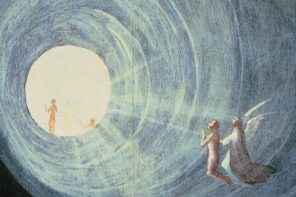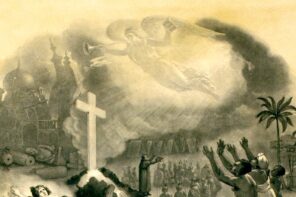I lie a lot on airplanes. Not in any way that should upset the TSA or anything like that—just to the question “What do you do?” I don’t like admitting to strangers what it is I do. I’m a Ph.D. student in religious studies.
I always have a book with me when I fly because I’m always supposed to be reading something. These books are usually about religion and American history or culture. They often tip people off. A friend of mine, another religious studies Ph.D. student, tells the story of the time he was reading Isis Unveiled in a local coffee shop. He was approached by a very excited man with an interest in Theosophy and other sorts of New Thought systems who talked his ear off for an hour. My friend is Catholic and was reading the book as a bit of research for some project or another.
The encounter between my Catholic friend and the enthusiastic Theosophist sums up why I feel uncomfortable on airplanes. I don’t want to run into true believers. I don’t mind telling someone I study religion. But it’s very different then to tell someone I study their religion. It just seems impolite. Like saying I study their grandmother’s recipes.
As I learned in college, religious studies is predicated on a notion of bracketing. “When we study religion academically,” professors tell students every semester, “we bracket our own beliefs and ideas so we can better understand others.” When I tell a stranger that I study religion in America the first question is always “What do you plan to do with that?” But the second question always begins, “so, what do you think about…” What do I think? I bracket what I think. That’s the point. Sometimes I try to bend the question to some neutral space where I can offer a well-informed opinion that brings historical clarity without actually taking a side. Other times I just mutter something and go back to my book and wonder if this bracketing is rude, unnecessary, and silly. Shouldn’t I just tell the tourist in seat 17B what I really think?
I recently happened up on a little book that answered that question for me. In his new history of the origins of the field, Religion Enters the Academy (a little three-chapter book perfect for plane rides), James Turner narrates the rise of comparative religion in America from the late eighteenth century to the turn of the twentieth. In Turner’s story, the earliest scholars of world religions did not actually bracket their own beliefs. He says,
the discipline of religious studies was born from a felt need to measure Christianity against alternatives. Such comparison aimed either to make Christianity more persuasive to the ‘heathens’ or to perfect Christianity by locating the elements of a universal religion common to all people.
Religious studies began as a uniquely Christian project.
The Christian template allowed for reductive, and even harmful, depictions of non-Christian religions. Furthermore, by keeping Christianity central, early studies in comparative religion universalized uniquely Christian categories. So, when you studied religion you studied texts, beliefs, and institutions—very nice Protestant categories.
As Robert Orsi has put it,
Religious studies has been very much the theoretical enforcer of a normative and unchallenged liberal Protestant and Western religious modernity; to put this less theoretically, the academic study of religion […] has long reinforced and given ‘scientific’ sanction to common social prejudices.
Orsi warns that the Christian project Turner describes is alive and well in the field.
James to the Rescue
At the end of Turner’s book, however, a hero emerges to wrestle religious studies from its reliance on Christian categories—his name is William James.
James’ The Varieties of Religious Experience did not compare Christianity to other religions. In fact, Turner describes it as a piece of “academic intellectual reform.” James “regarded the essential core of religion to lie in inner religious experiences—the ultimate source of and reason for, as he saw it, all religious thought and practice.” He threw out the Protestant categories of texts, beliefs, and institutions. He placed contemporary religious experiences alongside each other regardless of what religious tradition they emerged from. He flattened out the category of religion and “stretched the map of religious studies in America.”
Turner points out that though Varieties became an instant classic, it did little to reshape the field in James’ image. Rather, James only found an audience decades later after religious studies grew as a discipline in the wake of World War II. In 1964 the National Association of Biblical Instructors changed its name to the American Academy of Religion; a sign that what James had started was beginning to take hold.
In our time, the failure to bracket might not lead to Christian bigotry in our understanding of religion. But it could lead to a secularist prejudice just as toxic. If the early investigators of world religions believed them to be lesser forms of Christian truth, then our own postmodern investigations might just as easily render them in categories derived from our own scientific or secularist dispositions.
Religions were compared to Christianity in the past; now they can be explained away by science. Neither approach helps us understand the ways religions function in people’s lives. We need robust accounts of the sacred that avoid either sectarian prejudice on the one side and reductionism on the other. I’m not quite sure what that will look like, but I hope to find out.





